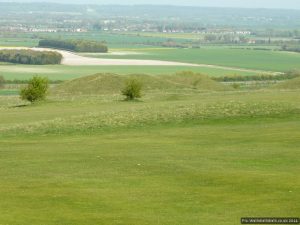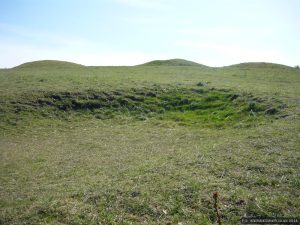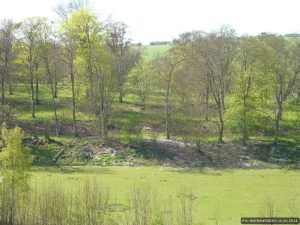Sunday morning, and we’re feeling like we could really do with a lie-in, having run 10 miles the previous day. Unfortunately, we know that to have one would mean missing out on an event that we’re quite keen to go to – a guided walk organised by Hertfordshire’s Countryside Management Service around Therfield Heath, near Royston, just across the border from Cambridgeshire and the Fens.

The walk is set to focus on prehistoric archaeology, a particular interest of ours, as well as on visiting some rare wildflowers that are blooming at this time of year – the heath being particularly rich in both and also having the ancient Icknield Way trackway running across it. Accordingly, we drag our weary selves out of bed, force down breakfast and drive to the outskirts of Royston just in time to meet the walking group on the verge of leaving the car park.
Our first views of the site confirm that we were definitely right to make the effort. Therfield Heath is the biggest remaining area of chalk downland in the east of England and even the most cursory glance across the horizon shows how rich in archaeological features it is. As we learn during the course of the morning, its barrow cemetery includes a magnificent Neolithic long barrow dated between 4,000 and 2,300 BCE, of the sort you’d hike miles across Salisbury Plain to look at, as well as 12 Bronze Age round barrows dated to c.2,300-750 BCE.

The mounds have been extensively interfered with by Victorian antiquarians and landscape improvers, as is so often the case, which activity must have made a nice change from wrecking churches. However, we learn that they did leave sound written records of their investigatons, and that the mounds generally contained the ashes of a single cremation, often in a pottery vessel, and sometimes accompanied by ritual objects. At least one was re-used for a Saxon burial.
Here is an aerial view of the complete site, courtesy of Google Maps:
We are particularly lucky to have the secretary to the Therfield Heath Conservators along today, to talk about the common, its history and archaeology, and recent attempts to improve the quality of the landscape. Then it’s time to climb up to the south-western corner of the site, threading through golfers as we go, for a distinct change of emphasis. Instead of chalk downland we are now in the sunny beech woodland of Fox Covert, and botany rather than archaeology has become our focus.

It turns out that this is the perfect time of year for pasque flowers (Pulsatilla vulgaris), a shy and early-flowering species related to the anenome that only thrives on undisturbed chalk downland. We are standing in the middle of Hertfordshire’s (and possibly England’s) biggest colony and we are no longer alone – as well as the guided walk group, the hilltop is now alive with visitors come to see these rarities in bloom. Suddenly people are lying face down on the ground aiming cameras into the grass, pointing the flowers out to small children or leaning right over the edge of a steep scarp slope to see the best collections of blooms.
The pasque flowers are a real hit, and the landscape they are situated in also provokes plenty of interest, with a terraced lynchet system, now wooded, visible on the slopes of a hill opposite – plenty of food for thought for amateur landscape archaeologists. But we are in grave danger of falling behind schedule and the charms of Sunday luncheon are becoming increasingly evident to the assembled throng. So it’s back through the wood at a brisk pace, over the downland with a chance to get another view of the long barrow, and across the now much quieter golf course to the car park.

However, a strong wind has brought out a kite flier, and plenty of people are walking their dogs. One enquires what we are doing. On being told he is looking at a Bronze Age barrow cemetery he says: “I had no idea! I thought that was just spoil from the golf course That’s made my day.” The walk’s been great – but this is very nearly the high point.
• To find out about future events lined up by the Countryside Management Service, check here.
Further reading
- Herts and Middlesex Wildlife Trust: Fox Covert and Therfield Heath
- Hertfordshire County Council: Archaeology sites – Therfield Heath
- Natural England: Therfield Heath SSSI
- Wikipedia: Therfield Heath
- Geo-East: Chalk East
- North Herts District Council landscape character assessment: Scarp slopes south of Royston (PDF)



















































